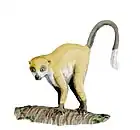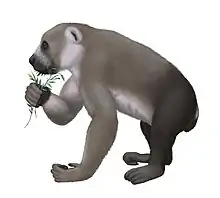Bugtilemur
Bugtilemur is an extinct genus of Strepsirhine primate belonging to the adapiform family Ekgmowechashalidae.It is represented by only one species, B. mathesoni, which was found in the Chitarwata Formation of Pakistan.[1]
| Bugtilemur Temporal range: | |
|---|---|
| Scientific classification | |
| Domain: | Eukaryota |
| Kingdom: | Animalia |
| Phylum: | Chordata |
| Class: | Mammalia |
| Order: | Primates |
| Suborder: | Strepsirrhini |
| Family: | †incertae sedis |
| Genus: | †Bugtilemur Marivaux et al., 2001 |
| Species: | †B. mathesoni |
| Binomial name | |
| †Bugtilemur mathesoni Marivaux et al., 2001 | |
When first described, Bugtilemur was classified in the lemur family Cheirogaleidae, complicating the picture of the early evolution of lemurs by suggesting that lemurs originated in Asia.[2]
Described from a few teeth, the specimen possesses a lower canine that, according to Marivaux et al., confirms the presence of the strepsirrhine-specific toothcomb. Furthermore, on the basis of cheektooth morphology, the molars share strong affinities with those of the genus Cheirogaleus (dwarf lemurs).[3] However, Bugtilemur appears to be much smaller than the extant Malagasy genus and its toothcomb was shorter and broader.[4] More recently, the structure and general presence of the toothcomb in Bugtilemur has been questioned, as well as many other dental features, suggesting that it is most likely an adapiform.[5] The adapiform nature of Bugtilemur was confirmed in a 2016 cladistic analysis that recovered it in the family Ekgmowechashalidae, which is more consistent with the lemur fossil record.[6]
See also
References
- "Bugtilemur". The Paleobiology Database. Retrieved 2009-07-08.
- "Earliest Evidence Of Lemurs Discovered In Pakistan, Far From Their Current Home, Science Reports". ScienceDaily. American Association For The Advancement Of Science. 294: 587–591. 22 October 2001. Retrieved 2009-07-08.
- Marivaux, L.; Welcomme, J.-L.; Antoine, P.-O.; Metais, G.; Baloch, I. M.; Benammi, M.; Chaimanee, Y.; Ducrocq, S.; Jaeger, J.-J. (19 October 2001). "A fossil lemur from the Oligocene of Pakistan". Science. 294 (5542): 587–591. Bibcode:2001Sci...294..587M. doi:10.1126/science.1065257. PMID 11641497. S2CID 10585152.
- Gould, Lisa; Sauther, Michelle L., eds. (2006). Lemurs: Ecology and Adaptation (Developments in Primatology: Progress and Prospects) (1 ed.). Springer. pp. 8–9. ISBN 978-0-387-34585-7.
- Godinot, M. (2006). "Lemuriform origins as viewed from the fossil record". Folia Primatologica. 77 (6): 446–464. doi:10.1159/000095391. PMID 17053330. S2CID 24163044.
- Ni, Xijun; Li, Qiang; Li, Lüzhou; Beard, K. Christopher (2016-05-06). "Oligocene primates from China reveal divergence between African and Asian primate evolution". Science. 352 (6286): 673–677. Bibcode:2016Sci...352..673N. doi:10.1126/science.aaf2107. ISSN 0036-8075. PMID 27151861.

